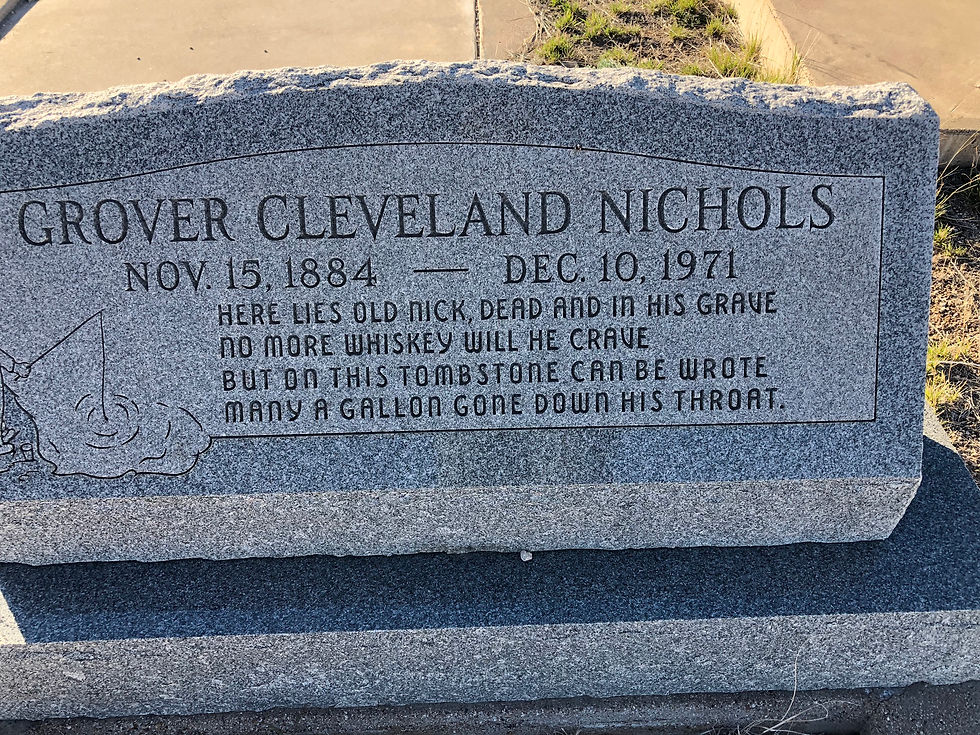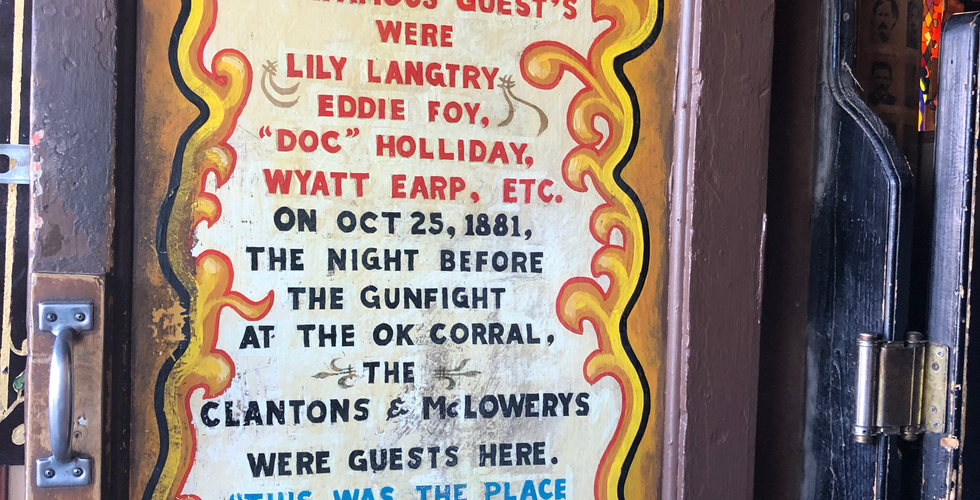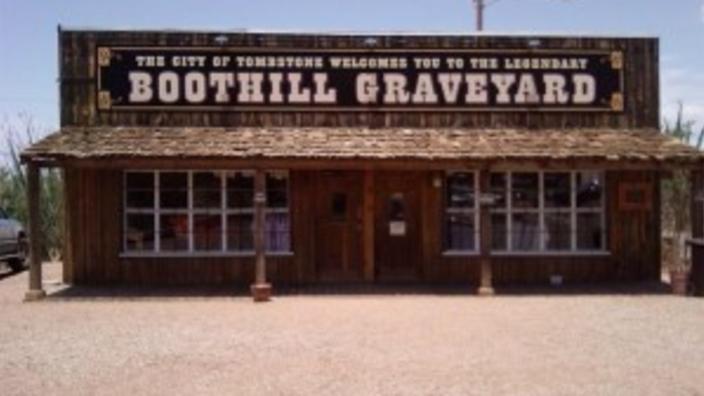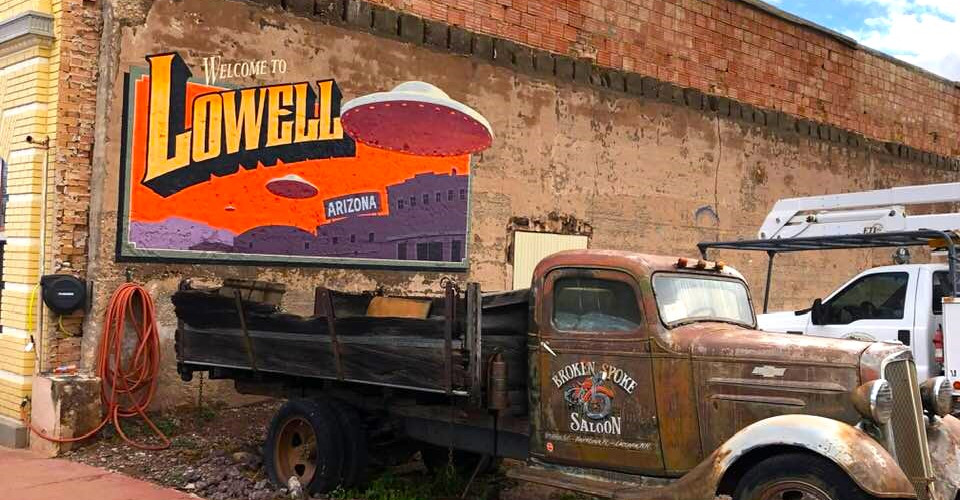Who's Your Huckleberry?
- Spencer
- Jun 24, 2024
- 9 min read
Updated: Apr 8
-- You'll find out in Tombstone, Arizona! --
..AND THE WORST CAMPGROUND AT WHICH WE HAVE EVER STAYED!

The next leg of our journey was to take us to Arizona and will allow us to add state number 26 to our travel map (as of March, 2019)!

Our next stop was a three hour drive from Silver City, NM, Stampede RV Park conveniently located in the heart of Tombstone, Arizona, and was the 76th campground at which we've stayed since leaving Delaware.

If you enjoyed the movie, you have to visit the town.

TOMBSTONE:

If you're familiar with the eponymous named movie, then you know the historical significance of this town in western lore. It sprang up in 1878 after a large silver deposit was discovered in "them-thar" hills. Miners, pioneers and fortune seekers flocked to the area causing it's population to swell from about 100 inhabitants to over 15,000, making it the largest city west of the Mississippi.
If you visited during its heyday, you would have found a bowling alley, four churches, an ice house, a school, two banks, three newspapers, and an ice-cream parlor, 110 saloons, 14 gambling halls, and numerous brothels.
This sudden prosperity also attracted a seedier element: card sharks, cattle-rustlers, criminal gangs and the like. After a fatal shooting left an opening for a town marshal, Virgil Earp was hired to bring law and order to this frontier town. Earp's brothers, Wyatt and Morgan, along with Doc Holliday, were hired on as deputies. To make a long, fascinating story short, a small gang of cattle-rustling outlaws, calling themselves the Cowboys, became embroiled in a personal and professional feud with the lawmen.
During one particular confrontation, when Doc Holliday --a man that never backed down from a fight-- was threatened by a member of the Cowboys gang, he responded [if it's a fight you're looking for..], "I'm your huckleberry!" Although there are many opinions on what the actual phrase means, most historians believe he was conveying that "if it's trouble you want, I'm your man".
The conflict exploded in an alleyway on Fremont Street (not actually at the OK Corral) at 3:00pm on Wednesday, October, 1881...

..But more on this in a minute. Let me first tell you about our campground experience.

WELCOME TO STAMPEDE RV PARK:
Now, we have stayed at many gritty, two or three-star campgrounds along our journey. But when we look beyond the weeds, the stray cats, perhaps unlevel or muddy sites, each one has managed to have at least one redeeming quality. Something that made us say "yes.. BUT they did have [fill in the blank]..". Perhaps the staff was extremely hospitable; maybe the campground offered free firewood; or a weekly potluck meal; or perchance a neighbor warmly greets us with a wave and asks: "Hey?! You're coming over for dinner, aren't you?" Whatever this small but memorable touch is, it can transform a campground from a wart-covered-frog into a.. Well, a frog with a few less warts.
But let me tell you, Stampede had none of these. NONE! It was the absolute worst.
This RV park was probably built in the 1960's and seemingly has not seen a dollar's worth of renovation since. First, the sites were extremely narrow (see the pictures below). We were wedged in like pieces in a jigsaw puzzle. When I stepped out of our RV, I could actually reach over and touch the rig next to us. We could hear the conversations our neighbors were having inside their RV, from inside our RV! Never have we been in a campground where the sites were this close together!
But that's not the worst of it..
The interior roads were dangerously narrow, so much so that we watched an RV scrape against a metal pole as it attempted to make a tight right turn.
But that's not the worst of it..
The electrical system was so weak and aged that we lost power numerous times.
This is the worst of it:
As I was emptying our black tank into the park's sewer system, my nostrils were assaulted with a most foul odor. The pungent scent of raw sewage. It rolled in like a heavy fog over the Moors. I hastily began looking inside and under our RV to see if a drain pipe had broken, but everything looked in order. Then the gurgle of flowing liquids greeted my ear. Whirling around I see my business flowing up and out of the sewer connector in the (empty) site next to us. Having never encountered this before, it took me a few eye-blinks to put two-and-two together (get it!?).

I immediately closed my tank and contacted the (85 yr-old-ish) owner who's attitude was that every problem in his park was someone else's fault. His solution was to screw the sewer cap down nice and tight. For the health and safety of those camping nearby, I expected him to hose down the lot but he expressed no concern and turned and walked away. With great trepidation, I opened my flush valve again, fortunately this time there were no issues. Just crazy. In case you're wondering, I did wash down the site.
AND this is the cherry on top..
Parked behind us was a row of permanent RV residents. Judging by the condition of their RV's, most had been here for quite some time. As I was having my ordeal, I looked over and saw them seated in their lawn chairs watching the show. As the tsunami of effluence was flowing in their direction, I expected them to scatter in horror. Nope, they just watched. Perhaps this is a common --yet no less disgusting-- occurrence here!
After this incident, we approached the KOA just outside of town begging them to let us stay at their park, but sadly (and understandably) they were completely booked.
Do your own research. As I mentioned earlier, we stayed here about five years ago and perhaps things have improved since our stay.

NOW, BACK TO TOMBSTONE:
Tombstone is like the Haunted Mansion ride at an amusement park; you know it's not real but it's a heck of a lot of fun to pretend.

And it is easy to drift back in time here. While I expected something hokey, instead I found a place remarkably well preserved. Even though very few of the original structures are left, each new building has stayed true to the architecture of the period. Here, while you stroll wooden sidewalks, you can belly-up to the bar at Big Nose Kate Saloon [named after an American outlaw, gambler, prostitute and longtime companion and common-law wife of Doc Holliday]; or visit the haunted Bird Cage theater; or visit the secret room where an unassuming mop-hand by day, would tunnel each night into the mine shaft running directly beneath his bedroom, and do his own prospecting :
While there are also shops, museums and other western attractions, make sure you go to the "Shoot out at the OK Corral" show. Three times a day, actors gather to reenact the gunfight that put Tombstone on the map.
The show runs about half an hour and costs $10/person and was worth every penny!


AS LONG AS YOU'RE HERE, YOU MIGHT AS WELL VISIT:
BOOTHILL GRAVEYARD. Okay, I thought this attraction was kind of hokey, but for only $3, you have to go. Folks in the town like to say many of the people that died in Tombstone are buried atop this hill; but are they telling the truth? Who knows. This plot of land used to be named Tombstone Cemetery up until newly built roadways began bringing waves of tourists to this area. In the 1920's, the cemetery got a face lift along with a catchy new dime-store-novel name.

It was Tombstone’s first cemetery, established in 1878.
Many of the markers have pithy sayings such as "HERE LIES LESTER MOORE. 4 SLUGS FROM A 44. NO LESS, NO MORE" ..I'm not buying it, but it is a colorful and perhaps fictitious retelling of the town's past. If you're interested in learning more about the cemetery's occupants, click here.

A TOWN'S FIGHT AGAINST THE COMMON HOUSE FLY!:
Twenty-seven miles southeast of Tombstone in the Mule Mountains, is the dusty tourist town of Bisbee. As with many towns in the west, the discovery of valuable ore was their antecedent. In 1877, a reconnaissance detail of the U.S. army was searching the area for renegade Apaches when they found signs of mineralization indicating the presence of lead, copper, turquoise and silver. The first mining claim was staked and the town was founded (named after a local judge and investor in the mine). The town sits in a gulch with multiple rows of steps leading from one street to the next.

It was in the summer of 1912, that the town was over run with flies, so they came up with an idea; they set up a contest to see who could kill the most house flies. The winner would receiving a prize of 10 dollars. That winner was Richard Phillips, who killed (give or take) about 500,000 flies. A plaque in downtown Bisbee, near the Mining Museum, provides more information:

It reads as follows:
SWAT A FLY, COP A PRIZE! In August 1912, the Commercial Club of Bisbee went public with a novel method of fly control. The seriousness of the continuing typhoid problems experienced in Bisbee around the turn of the century found some relief in humor as well as creativity. The rules for a 'systematic campaign of extermination' against those 'advance agents of pestilence' were quite straightforward. . . . and the pestiferous little nuisances must now take the consequences. They will be bottled and trapped and caught, done up in packages and duly measured up and counted. . . It makes no difference how the dead flies are obtained or where within the district. They may be killed either with sticky fly paper, caught in traps or just swatted with a swatter, folded newspaper, or any other fly-killing device. If caught on sticky paper, however, they must be picked off, the committee not volunteering to do this work for the contestant. When a contestant desires to turn in his or her proof of prowess as a fly exterminator, the flies are to be placed in . . . a pasteboard box. The county health officer will be the judge of the contest and will count and measure flies that are killed. Bisbee has taken a position at the front in advance of all other cities in the southwest in war upon the fly and typhoid fever germs… – Bisbee Daily Review, August, 1912 The anti-fly crusade is at its end. Richard Phillips was the winner of the competition, exterminating within 5,000 of 500,000 flies – Bisbee Daily Review, September 3, 1912 The effectiveness of such a campaign? Alas, "more flies this year than last, despite a more aggressive fly-swatting campaign among the public generally…" – Bisbee Daily Review, June 8, 1913
All that aside, Bisbee is a cute artist town that is an interesting place to poke around. If you feel adventurous, there are some trails that take you above the town that give you a bird's-eye view of the town.
And, be prepared for a lot of these:

Because the town is built into a hillside, the roads are very windy. Therefore, it is easier to get around using the many stairways that ascend the hillsides. In fact, if you're up to the challenge, you can participate in the Bisbee 1000, a 4.5 mile run that includes over 1,000 steps!

LAVENDER COPPER MINE:
Just outside of town is the Lavender Pit Copper Mine which is worth a visit.




The mine opened in 1954 and closed in 1974. It produced over 86 million tons of ore. Turquoise was also a by-product of this mining activity. It is among the finest turquoise in the world and has become known as Bisbee Blue turquoise.

THE ABANDONED TOWN OF LOWELL:

And, here is it's main street:

What looks like a scene from a 1950's post-apocalyptic movie, is actually all that remains from a once thriving town populated with miners from countries such as Finland, Serbia and Montenegro. It now lies completely abandoned, as if someone just locked the front door and walked away.
So here's what happened. In the late 1950's, the mining company wanted to expand the size of the Lavender Pit. This required buying up most of the homes in the residential section nearby. About half of the town's population was relocated to surrounding communities. As the population dwindled, the businesses along main street shuttered one by one. Instead of letting the town erode away, a community of passionate and dedicated citizens banded together to create a distinctive outdoor museum dedicated to the era of the 1950's.
This unique location is one of the most photographed streets in the West and has been the backdrop for various film and video shoots.
This is a living snapshot of a bygone era. Thanks to the volunteers that diligently maintain this living museum. Visitors have a chance to experience a unique and somewhat spooky slice of Americana.

We thoroughly enjoyed our time in southern Arizona and find the desert immense and captivating in its austere vastness. It's colorful and sometimes tragic history, only adds to its mystique.
One last photograph before wrapping things up, we stopped by the real cemetery in Tombstone to read some of the inscriptions and came across a man who died with a very good sense of humor:

The inscription reads:
GROVER CLEVELAND NICHOLS:
HERE LIES OLD NICK, DEAD AND IN HIS GRAVE. NO MORE WHISKEY WILL HE CRAVE. BUT ON THIS TOMBSTONE CAN BE WROTE MANY A GALLON GONE DOWN HIS THROAT.

From here we headed north towards the red hills of Sedona, but more on that in my next post. See you on down the road.















































































































Your campground, my worse nightmare!